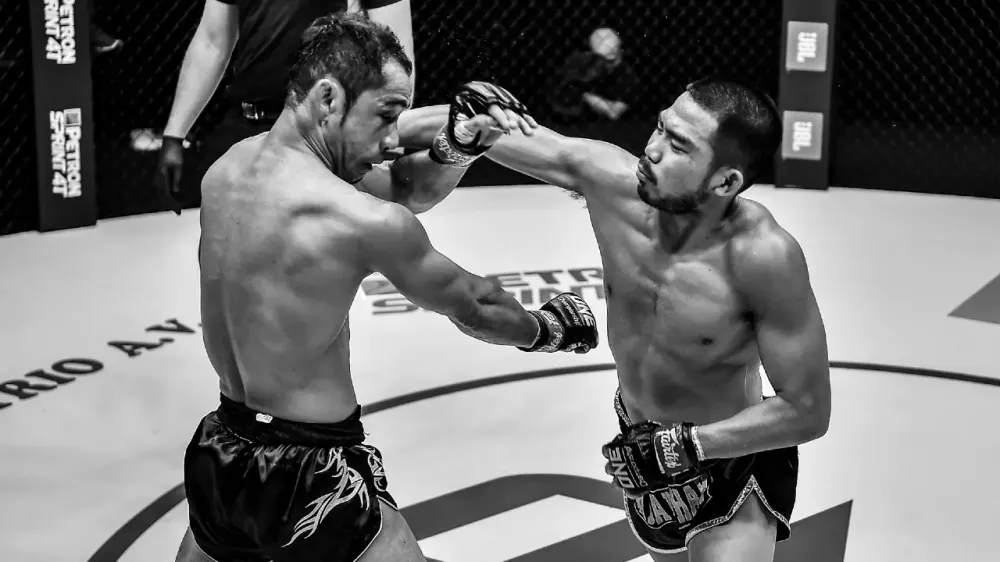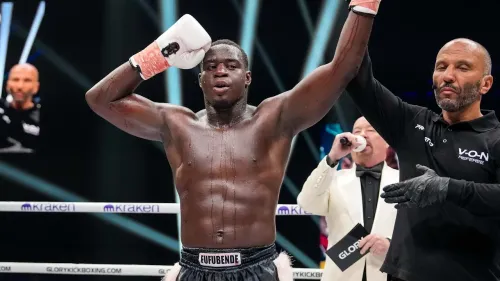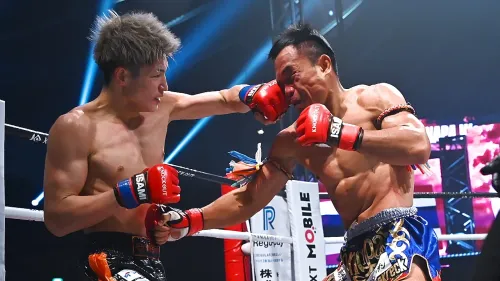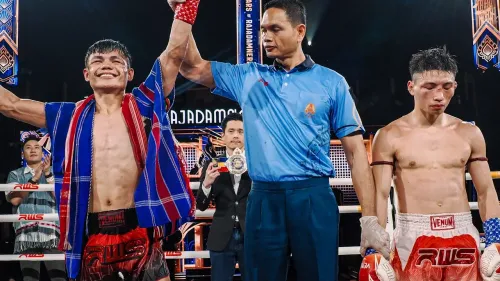Two titans of the Thai stadium circuit – Sam A Gaiyanghadao and Prajanchai PK. SaenchaiMuayThaiGym – met on July 30 in 2021, to set a new high-water mark for striking in 4 ounce gloves.
After five grueling, tightly contested rounds, Prajanchai came away with Sam-A's ONE Championship title. After an eventful two years, we’re back for the rematch – this time for the interim belt. As preparation, we’ve dug into the first fight in detail, celebrating the tactics on show and just what a phenomenal fight it was. First, the context: who are they, and why are they now fighting for an interim title?
BACKGROUND
With close to 400 wins each, both fighters can boast of a trophy case full of the most prestigious titles and awards in Thailand. Sam-A will be 40 years old in October and is competing more than 15 years removed from his career peak, in a sport where many fighters age out at 25. Slick, powerful, and one of the most experienced Thai athletes in the world, his technique is perfectly honed and formidable.
Prajanchai, 28 at time of writing, came to ONE Championship as the undisputed king of the lower weight classes on the stadium scene. A versatile, tricky kicker, and quick combination puncher. Prajanchai has beaten who's who, while moving up in weight facing bigger fighter. He is a two-time Lumpinee champion, two-time Rajadamnern champion, and even won the WBC South Asia boxing title at 126 lbs. A quick, smart, dogged and versatile fighter, he was a clear favorite in the first match, but without a doubt left the ring with new respect for one of the great veterans of the sport.
Since the first fight, Prajanchai has suffered one of the most shocking, incredible upset defeats the sport has seen in years. His first title challenger was Joseph Lasiri, spotting a 5W-6L record in the previous five years. Despite the significant height and reach on Prajanchai, the Thai having had so much success fighting up in weight in the past, very few people predicted a competitive fight. Lasiri shocked everyone by showcasing a mobile boxing game that made great use of his long reach to carve through Prajanchai’s guard. The champion looked flat, stationary and a little out of shape, and quickly absorbed a perfect lead uppercut that split his brow open. With blood in his eyes and a mountain to climb just to get into the fight, he quit on the stool after three lopsided rounds to Lasiri. Joseph would then move up in weight to be absolutely run over by Rodtang.
After the biggest and most embarrassing defeat of Prajanchai’s career, the bounceback fight was a booking with the imposing Kompetch, a top-shelf stadium fighter who had just become the number one contender for the K-1 kickboxing title. Prajanchai outclassed Kompetch, rocked him badly, knocked him down in the next round and generally took his lunch money Fans following Prajanchai's career in this period contracted whiplash.
Sam-A meanwhile has won three in a row. He had a rough night with the tall pressure fighter Thongnoi, controlling the fight early and getting a knockdown in round three, but hanging on desperately by the end while the younger man poured on the offense. The next two were stronger showings: a clean decision over the highly regarded Samingdam and a knockout against the solid Ryan Sheehan. It remains to be seen when his inevitable drop-off will arrive.
ROUND 1
Prajanchai starts advancing immediately: threatening the right kick to eat up more space, and using a throwaway jab to land to the body once he has Sam-A on the fence.
Prajanchai immediately seized the initiative and set the pace of the opening round. Use of feints and a flicking jab kept Sam-A reactive and allowed Prajanchai to score repeatedly with a right body punch and kicks from range. Sam-A fought defensively with his jab and teep, searching for counter opportunities while Prajanchai's kicks landed to the legs and arms.
Sam-A steps past Prajanchai's lead foot and lands a clean body kick as Prajanchai turns to keep track of him. Prajanchai fires back, hitting the elbow. Sam-A pops a jab moving backwards and deflects a three-punch combo from Prajanchai.
After the first minute of the fight, Sam-A began to counterattack with powerful left kicks to the body and legs. Prajanchai, trying to limit these opportunities, would bring his feet together to step forward in a tall & narrow stance, edging Sam-A backwards while ready to block or interrupt with the teep.
Sam-A's defense kept him remarkably safe from punches to the head in the first round. Prajanchai attacked the head mainly with a right cross, setting it up with a series of blinding jabs and jab fakes. Deft backward steps, combined with pulls and the use of the forearm to parry, allowed Sam A to glide away from Prajanchai’s flicking jab while consistently deflecting the power punch. As he settled into the fight, he began to find his moments to answer the attack; by midway through the round, the kicking battle was becoming even.
Prajanchai lands a lead leg low kick and Sam-A responds with a hard rear leg kick to Prajanchai’s back leg. Prajanchai immediately presses in and fires a body kick, which Sam-A catches and counters with a cleaner body kick under Prajanchai’s elbow.
Despite keeping up his pressure and outlanding Sam-A through round 1, Prajanchai began to find himself on the losing end of the kicking exchanges when Sam A fired back. Though he was scoring less regularly, Sam A's kicks were landing harder and cleaner, and for a few moments it looked like he had found his rhythm and could steal the round. But just as AAA began to gather steam, Prajanchai found Sam-A's rhythm too.
Prajanchai anticipates Sam A's left kick coming on the half beat. He doesn’t quite get the shin check up in time, but catches the leg and drives forward to upset Sam-A's balance. As he releases the leg Sam-A’s left arm drops to counterbalance, and he arcs a high right overhand through the gap.
Any elite Nak Muay is competent at catching and countering kicks in larger gloves – in this fight both athletes found consistent success with catches. Prajanchai punches with the catching arm, landing a hard blow from a blind angle before Sam A had fully regained his balance. Having won a 10-8 round under ONE Championship rules, Prajanchai carried a strong lead into the second frame.
ROUND 2
Prajanchai lands two low kicks, then predicts the kick counter and exploits it with the teep. Breaking your opponent’s balance like this scores very highly in the Thai stadiums – it’s unclear whether this counts for much under ONE rules.
A consistently effective change-up for Prajanchai during round 2 was the rear leg quintuple threat of inside low kick, body kick, high kick, knee and teep. Each move comes from a forward motion of the rear hip and knee, making the job of predicting the target extremely difficult. Prajanchai scored good shots to the leg, body and arms like this, and generally escaped any counters in the process.
Prajanchai teeps the thigh, handfights, then threatens the left hook to mask a step to the outside angle for a nice knee. Both men make themselves difficult to punch and exchange kicks to the arm. Note that Prajanchai’s kick lands much lower, level with the ribs, and hits near the elbow.
Sam-A meanwhile was mixing his kicks less, but repeatedly landing hard to Prajanchai's arms. This eventually left Prajanchai's arm badly damaged and may have contributed to Sam A's late rally, but at this stage in the fight Prajanchai was outscoring him. Notable tricks from Sam A included doubling up (hitting the leg and then immediately coming high with the same leg) and varying the rhythm of his shots to attack on the half beat.
In this 12-second sequence, Prajanchai twice looked to use his jab to take the same outside angle he had found repeatedly in round 1. Sam-A by this point was wise to the trick: first tracking Prajanchai’s turn to nail him with a hard cross, and secondly using the long guard to deflect a series of jabs and attempted left uppercut. Prajanchai largely stopped attempting the move after this point.
The commentary desk fixated on the higher activity rate of Prajanchai and his flicking jab as signs that he was running away with the early rounds. I disagree. Each time I've watched this fight, I've noticed more and more ways that Sam-A was succeeding with his more subtle offense. When Prajanchai used his jab less in the second half of the fight, I suspect it had nothing to do with an injured hand, and everything to do with the lack of success he was finding with it. Having twice tried to initiate offense with the jab here, Prajanchai got nothing for it but punched in the mouth. The left uppercut doesn’t land either, but it was a nice attempt and the idea would pay off for him as the fight went on.
Prajanchai again uses the lead uppercut, this time to land a right hand – whether it hits the left arm or the face is unclear from the camera angle. A teep, a clean counter right hand, and Sam A immediately hammers in two kicks to Prajanchai’s right arm.
Kicking the arms to neutralise punchers is a common tactic in Muay Thai and kickboxing, though most often seen from Thais. The idea is twofold: the attacker is made to worry about punching at the wrong time, moving the barrier between the incoming shin and the ribs or head; but just keep blocking, and the bruising quickly builds up, to the point that the arm is no good as a shield or a weapon. Sam A demonstrates here by immediately firing in two hard kicks to the arm after taking a couple of right hands.
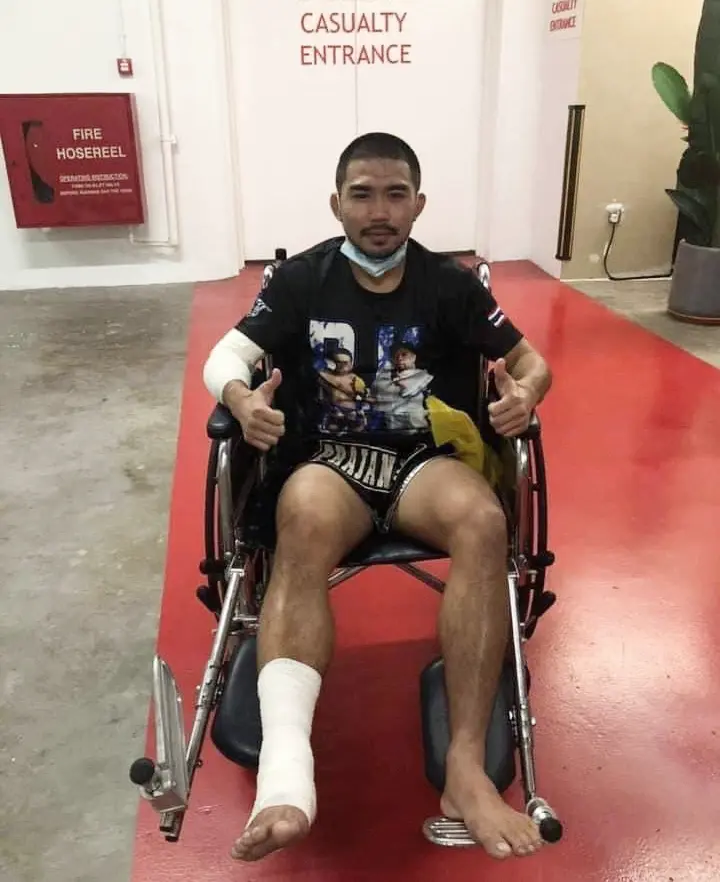
Prajanchai’s right shin and arm were injured during the contest. Incredibly, despite hurting it in the second, he kicked with the injured shin throughout all five rounds.
Feint jab, left hook, right hook, left uppercut, right cross. Three clean power punches from Prajanchai.
Prajanchai hit on a key adjustment here at the end of the second round. His flicking jab was being ignored as a non-threat, and Sam-A consistently picked off the single power punch. By extending the exchanges as he did here, throwing four power punches in place of one, he began to find his mark. Notice that Sam-A again deflects the first power shot, but Prajanchai strings together another three behind it to catch him. Another strong ending to what had been a very close second round.
ROUND 3
Prajanchai attempts a 3-2 but is countered with the left kick. He takes two more hard kicks and left straights (landing a left hook in return), before both fighters pivot away from counter fire. Note that Prajanchai always needs a beat to recover his balance before attempting to counter Sam A’s left kick.
Round 3 opens with Sam-A landing heavy blows from the left side. His left kick and straight left hand attack at the same range, with a very similar wind-up, and Prajanchai is consistently caught on the end of the two punishing attacks.
Sam-A continued to fight a lower-volume fight than his opponent, attempting to bully Prajanchai with power shots. Prajanchai was diligent with his right leg check, defending his ribs: consequently, most of Sam A's kicks were deliberately sent high to the forearm instead. This allowed him to off-balance the momentarily one-legged Prajanchai by hitting him higher up on his body, and simultaneously to pile up damage on his right arm.
Defensively, both fighters were superb. Consistently escaping with pivots saved both from a lot of heavy shots – though both fighters at various points pivoted themselves onto the fence. It's tempting to blame a lack experience fighting in the cage versus the ring for this tactical misstep: in a ring, a fighter can lean back against the ropes, using the teep and extended arms to stay relatively safe. With a rigid fence wall behind you, leaning your head back out of range is not an option.
Sam-A feints a teep and triples up on his jab to reset. Prajanchai sees his opportunity to attack while Sam-A is trapped along the cage, and presses forward. Sam-A’s defense is excellent, using the teep threat and long guard to stay safe. Prajanchai keeps at it and eventually finds a hard left hook.
When Sam-A found himself caught in these bad spots, he kept himself remarkably safe: floating the right leg to teep and check kicks, and using a tight long guard to deflect punches without the benefit of large gloves. It took Prajanchai trapping Sam-A on the barrier three times in this round before he finally landed a good punch for his efforts. The long guard is a good fit for 4 ounce fights, not really dependent on glove padding to protect the head.
Prajanchai braces for the left kick and steps in with punches, touching Sam-A with the right hand. He then anticipates Sam-A’s left hand counter and parries, scoring three partial connections. Sam A then lingers in his long guard for too long and Prajanchai pops him with a gorgeous left uppercut.
One of Prajanchai’s clearest advantages in this fight was his more powerful and versatile lead hand. Sam-A has a nice jab, but he does his real damage with his rear side weapons. Prajanchai meanwhile threw left hooks and uppercuts to find ways around his guard with power punches. The next time someone tells you that beating a southpaw is all about the right hand, show them this fight.
ROUND 4
Sam-A catches the right kick, bringing his far arm across to scoop up the ankle and drag it across his body. When the leg is released Prajanchai floats the block, expecting the left kick, and Sam-A nails him with the left elbow. He puts the stamp on the exchange with two more kicks to the arm.
The fourth round, though still competitive, is the beginning of Sam-A picking up a clear lead. In the early going he did it with kick catches.
Bouncing into kicks (taking a forward step and springing off the lead foot) is common in Muay Thai, where the constant teeps and checks mean plenty of opportunity to disguise the step. It allows increased range and power, but the telegraph is present, and can be exploited if not properly hidden. Prajanchai in the fourth became slightly predictable with it, and this was all Sam-A needed to counter and sweep him repeatedly.
Prajanchai lands a nice right hand into left knee. Sam A gets the better position in the clinch with an underhook and bicep control, allowing him to turn Prajanchai and step out. As Prajanchai follows, attempting to line up a right hand, Sam A walks him onto a left elbow.
The clinch also emerged as an area of strength for Sam-A. Most who had followed the careers of these athletes would have expected the opposite, having seen Prajanchai’s much more recent dominance on the stadium circuit - this clinching is ever-present in the Thai stadiums, but Sam-A had only competed in ONE since his brief retirement in 2016, where clinch breaks are much quicker. He was nonetheless quicker to grab strong positions than Prajanchai, landing elbows and sending him stumbling with quick turns. Off-balancing him like this doesn’t score highly in ONE like it does in the stadia – though the elbows certainly do.
Having gotten the worst of the action through the first minute and feeling Sam-A press the attack, Prajanchai fell back on his default defensive pivot. He stepped left and turned clockwise, moving past Sam A's lead foot and away from his power strikes. In doing so, he put himself right on the cage. 'AAA' immediately made him pay for it.
Bodysnatching. Left straight and two hard knees to the solar plexus, then a counter punch that wobbled Prajanchai. An accidental knee to the groin gave Prajanchai a badly needed escape from the pressure cooker.
For all his accuracy and power with his punches, Sam-A seemed surprisingly slow to get around a simple double forearms guard from Prajanchai. A nice commentary on the different way Muay Thai emphasises the use of punches – most kickboxers, and many Muay Thai fighters, have a stronger influence from western boxing in their style and would immediately set to work carving through a static high guard in 4 ounce gloves, but Sam A's boxing is seemingly all about clean long-range straight shots.
Sam-A repeatedly targeted the solar plexus in this exchange. Prajanchai looks more visibly tired here than at any other point in the fight, and this fatigue probably made it easier for Sam A to both catch and hurt him with the followup left upstairs. The knee off the caught kick aimed to keep up the body attack, and the accidental low blow probably turned out to be a very costly mistake for the older man.
Prajanchai came out hot and reinvigorated after the break, pushing Sam-A back and throwing boxing combinations. Still having trouble avoiding Sam-A's left straight and finding limited success landing with his hands, he began to lean on the kick-cross (leading with the body kick and throwing the right hand as the kick is retracted) as a way to initiate exchanges. It worked for him more often than not, but got him caught and swept when not set up by feints. No matter how fast the kick, at this level, if it’s predictable it will be punished.
ROUND 5
By the fifth round both men were tired and the output from Prajanchai, rapid and constant early on, had dropped noticeably. He had a lot of trouble landing his cross without the variety of setups he used earlier in the fight, instead seeing Sam A use his excellent sense of distance to slide backwards out of range. To catch him in the wide open expanse of ONE's MMA cage, Prajanchai began using a trick which has been a mainstay in MMA striking for some time now – the forward shift.
Prajanchai misses a right cross from too far out, but steps through and lands a hard followup left from a square stance as Sam-A retreats. A followup 1-2 misses, but he steps deftly at an angle to escape return fire.
The amount of space fighters have to play with in a big cage means that retreating a few steps when attacked has far smaller penalties than for fights in a ring. Consequently, a popular MMA trick is to step the back foot through into the opposite stance when throwing the rear hand. Walking with the punches like this makes distance quicker, and often catches their opponents on the retreat. The risk here is that a shifting fighter is really *falling* between stances, and taking a punch in those moments can be catastrophic. An opponent focused on retreat though is often vulnerable. Prajanchai missed almost all of his lead rights in the fifth round, but landed a couple of hard follow-up lefts with the forward shift.
Sam-A evades a right cross and grabs the collar tie, hitting a left elbow. After a brief exchange of knees and elbows, Sam-A twists and throws Prajanchai back out to range.
The fifth round of the fight spent the longest amount of time in the clinch. While not one-sided by any means, Sam-A continued his slight edge, and I think it was enough to win him the round. He caught several clinches off missed punches from Prajanchai and seemed physically stronger – at one point throwing Prajanchai down on his hands. They almost score that like a knockdown in the stadiums.
Prajanchai lands a lead leg low kick, looks for another right hand, and misses. Sam-A’s left cross is faster and straighter and snaps his head back. Sam A closes out the fight with a kick-cross into a lovely body kick.
Sa- A showed off some seriously sharp long-range punching. Prajanchai's right hand was slower and more obvious, and Sam A packed an absolute laser of a left hand right into the final seconds of a championship fight. Beautiful stuff.
Like many older fighters, Sam-A has a fairly narrow toolkit – but what he does do is beautifully refined. The left cross is arrow-straight, long and snappy; the left kick is quick and powerful. The sheer mechanical efficiency of his style must be one of the major reasons a then 37-year-old fighter weighting 125 lbs managed to compete with an elite opponent more than decade younger across five hard rounds.
CLOSING THOUGHTS
Prajanchai starts the fight from a much closer range than he finishes it, and this enables his active lead hand work to set up attacks. Sam-A's arm kicks may have persuaded him to back off to avoid the regular attritive damage: the fourth and fifth rounds were fought at a notably longer distance than the first three. Another factor was Prajanchai's activity rate – early on a constant stream of attacks, feints and teeps kept Sam-A's offense bottled up, but he couldn't sustain it for five hard rounds. Sam-A taking over happened largely as a result of consistent work he was doing all fight, and Prajanchai leading with punches from further out which he could avoid or grab the clinch from. The ranged kicking battle was very even throughout, but Sam-A's superior long-range boxing began to tell as the range changed.
In the clinch Sam-A usually got the better positions and won the exchanges on damage, though Prajanchai (while frequently off balanced and dumped) landed some good intercepting elbows of his own.
Meanwhile, Prajanchai's success was in volume and clever switchups. The use of thigh teeps to interrupt balance and the changeup threat of all the different, but similar looking attacks he has from the rear leg was all really smart, and he found a lot of success with it. He also tended to win punching exchanges with his more ambidextrous boxing game, whenever he could pin Sam-A in place for long enough for the left hook and uppercut. The rematch will be in the ring, not the cage, so the smaller space might play into Prajanchai's hands here.
In terms of scoring, I give the first three rounds narrowly to Prajanchai. The fourth was clearly Sam A's, and I think he narrowly took the fifth as well. I may have been a little biased in Sam A's direction with the clips: I like his style, and he tended to produce big, easily clipped moments, where Prajanchai fought with the higher output and more consistent scoring work. All in all I think the knockdown in round 1 made the difference for him.
